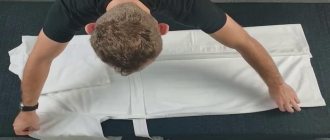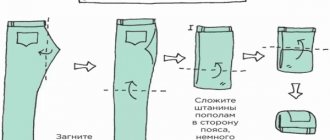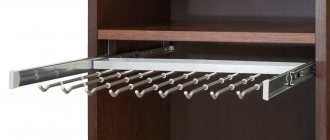Seasonal clothes keep you warm during cold, rain and snow, but take up a lot of space in your closet and on hangers on hot days when not in use. If you fold your jacket compactly for the warm season, you can free up space for everyday things, ensuring comfort, cleanliness and order in your home.
Proper organization of free space in the closet helps to maintain order in the house
Features of storing jackets
In a large family, the lack of free space is especially acute. Each adult usually has 2-3 jackets for the season, plus children's clothes, which take up space no less than the clothes of mothers and fathers. Before packing your jackets compactly for the winter, it is recommended to do the following manipulations:
- Check the general condition of the clothes: sew on torn buttons, fix broken zippers, shake out small debris from pockets.
- Wash or dry clean the jacket and dry thoroughly. It may be worth going to a dry cleaner to avoid ruining expensive items made from delicate fabrics.
- It is best to try to sell damaged or unsuitable clothes or give them away to someone free of charge, so as not to take up free space in the house.
For long-term storage, the item must be absolutely clean and thoroughly dried.
It is important not only to fold the jacket compactly for storage, but also to control the conditions in which it will be kept for several months. Fur items are afraid of moths and other pests; creases may appear on the skin from improper storage. Poorly dried product material can lead to mold ruining the jacket.
Each material has its own storage characteristics:
- Jackets made of natural fur. It is best not to wash such clothes, but to clean them dry. Treat the product with special products or an aerosol against pests. Instead of poison, you can use natural cedar oil. It is best to store a fur coat or fur coat on hangers in a fabric cover, which will ensure air circulation and prevent the clothes from acquiring a musty smell.
- Leather items. These jackets also have natural fur inside, so the product should be treated against moths. There are special products that soften leather products and prevent the formation of creases on the delicate material.
- Voluminous jackets and down jackets. Synthetic items do not have to be hung on hangers and placed in a fabric case; a simple bag from which the air must be pumped out will do.
You should learn how to fold jackets correctly so as not to spoil them and free up as much space as possible in your closet, bag or suitcase.
Storing bulky items in vacuum bags
Using vacuum bags and covers
Bags and cases for storing clothes are deservedly very popular among users.
This is due to the fact that they help in organizing your wardrobe and prevent the appearance of dirt. A protective layer is also necessary to protect the surface of the product from damage. Therefore, bags or cases make it easy to store and transport clothes. The bags are characterized by increased strength and tightness, therefore preventing foreign substances from getting inside.
Thanks to this placement, significant space is saved in the closet or suitcase.
If you want to ensure more secure storage and transportation, using any of the above methods is recommended to use a vacuum bag or case.
How to fold a jacket
It's worth considering a few simple step-by-step instructions for folding fall and winter items from various materials. They are simple, but every housewife will like the result.
How to fold jackets in a closet
If clothes do not have to be transported, they should be folded compactly inside the wardrobe. It is important to ensure air circulation and also to prevent bruises on the product. After washing and drying, warm, bulky items should be hung on hangers, after putting special large covers on them for clothes.
Proper organization of space and storage systems will help to compactly place things inside the closet. To do this you should:
- install hanging organizers;
- use the space under the ceiling;
- add hanging shelves;
- buy special separator inserts.
Seasonal items should be put away in the closet clean and dry. Light windbreakers should not be put on the top shelf, as they may be needed during periods of slight cold, even in the middle of summer.
Some tips on how to compactly store outerwear:
- Use the balcony space. You can install a wardrobe for storing clothes right on the balcony and hang fur coats, sheepskin coats, down jackets and leather jackets in special cases there.
- Buy several vacuum bags for storage. The property of these items is that they pump out all the air, thereby the jacket takes up minimal space in the closet, and also does not deteriorate from dirt, mold or insects.
- Throw away spoiled and unnecessary items in a timely manner.
It is important to protect fur items from insect pests
How to compactly fold a jacket into a suitcase
You can travel not only to hot countries; some people like to go to ski resorts or visit the northern regions. When going on a short trip during the winter holidays, you should take care of warm clothes and make more room for them in your suitcase.
Attention! Before packing for the trip, you should check the weather forecast in the place where you will go.
Some tips on how to compactly pack your things for the trip:
- Prepare thoroughly. You need to lay out all your clothes in front of you on the sofa or bed and sensibly assess the scale of the trip. You shouldn’t take too many things for 2-3 days, but you shouldn’t forget important items.
- Fold your coat. Products made from cashmere, drape, felt or other coat fabrics are placed at the very bottom of the suitcase. The item is folded using the shoulder-to-shoulder method. With this method, you need to turn one sleeve inside out and fold the delicate item of clothing in half so that the front sleeve is inside the turned sleeve. To prevent the item from being worn out, it is worth placing paper or a plastic bag between the halves.
- Warm jacket. The bulky item of clothing is also placed at the bottom of the luggage. The jacket must be folded beautifully. To do this, place the product on a hard surface with its back up, with the jacket's tails turned out and the sleeves with the collar straightened. Next, fold the sleeves in half, avoiding the appearance of random folds. Fold the floors up and fold the product in half.
Packing for the trip
How to put a jacket in a backpack
After transportation, the item should not lose its attractiveness, but sometimes you have to travel light. In a backpack, a bulky item should be placed in such a way that there are no creases or dents on the product. The procedure is approximately this:
- Turn the jacket inside out.
- Place the sleeves next to each other.
- Fold the jacket's tails so that they meet in the middle.
- Fold the item horizontally and place it at the bottom of the backpack.
Attention! Bulky items take up almost the entire luggage space; sometimes it is better to carry them on yourself to save space inside a bag or suitcase.
How to compactly fold a jacket with a hood
Warm products most often have a hood, which can be used as a kind of storage case. The jacket is zipped and turned inside out along with the sleeves. The inverted sleeves are laid on top of each other. The garment is rolled up and the ends are placed inside the hood. If there are ties or Velcro, they must be used.
Recommended reading: How to remove pellets from a coat
You can roll up a voluminous jacket not only into its own hood, but also into the pockets of the product. The clothes are buttoned up and the lining from the pockets is turned inside out. The lower part of the jacket or down jacket is tucked into the entry point of the product's pocket, and first one and then the second sleeve of the product is placed into it. Next, you need to tuck the top and bottom of the bulky item into the same lining.
Travel without unnecessary items
How to fold a jacket correctly
One of the simplest ways to roll up a warm item is called a roller. The step-by-step process is as follows:
- Turn the product inside out.
- Fold up the hood if it is attached to the jacket.
- Fold the sleeves at the back.
- Roll into a tight roll, starting from the bottom of the product.
In this form, it is recommended to fold the jacket into a fabric cover and put it on the top shelf of the closet until next winter. If the product is being prepared for transportation, it can be tied or secured with special rubber bands for reliability.
To store a warm jacket on shelves in a closet, fold it into a rectangle, so it takes up minimal space and does not interfere until the next season of winds and rains. The item of clothing should be placed on a smooth, level surface. The front of the jacket is placed on the table, the hood and sleeves are folded along the seam. Next, you need to fold the jacket in the center and press the bottom part up.
Folding jacket into pocket lining
What affects the safety of winter clothes
How long warm items can be stored without losing their characteristics depends on the following factors:
- Illumination . Most materials deteriorate when exposed to direct sunlight.
- Temperature . For synthetics, room conditions are optimal; natural down, fur and other fillers are best kept in a cool place.
- Humidity . Should be average or above average, but not excessively high.
- Ventilation . The place should be ventilated at least occasionally to prevent the appearance of pests such as moths and mold.
- Package . Sealed bags extend the life of most synthetic materials, but harm natural ones.
- State of things . Before sending them for summer storage, they must be cleaned; heavily soiled items should be washed.
Rules for folding jackets made of various materials
When packing things in a suitcase or for long-term storage in a closet, be sure to take into account the material of the product. Leather items, fur coats, fur coats and sheepskin coats can especially suffer from improper storage. Down jackets are less capricious, but they can also develop signs of bruising that will be difficult to remove.
How to fold a leather jacket
An expensive item will last a long time and will not lose its original appearance only if it is properly cared for. Leather jackets are a status item of clothing; they are treated with a special cream, wiped, dried and carefully stored.
We recommend reading: How to remove fungus from shoes: how to treat it at home
It is better not to fold or roll a product made of genuine leather, as this will prevent creases and dents from forming on it. It is recommended to place the jacket in a fabric cover and hang it on hangers in the corner of the closet. But sometimes a leather jacket needs to be folded compactly for transportation. The sequence of actions is approximately this:
- Fasten the jacket with a zipper or buttons.
- Turn the product inside out.
- Place the sleeves crosswise on the back.
- Place the hood on top of the crossed sleeves.
- Wrap the leather jacket as tightly as possible.
- Place the folded item in a fabric bag so that the item does not get dirty in transit.
Attention! If during transportation a leather jacket becomes wrinkled or creases appear on the material, do not be upset, the item can still be saved. An expensive item of clothing should be hung on hangers in the bathroom and the hot water flow should be turned on. Steam and humidity will help straighten out your leather jacket and restore its attractive appearance.
It is necessary to lay a bulky item compactly on a horizontal surface
How to fold a synthetic jacket
It is recommended to fold warm winter clothes into a rectangle for storage in the closet - this way they will take up less space and free up space for summer clothes. The compact method involves the following procedure:
- Place the jacket on a flat surface facing away from you.
- Place the sleeves on the back and cover them with the hood if it cannot be detached.
- Fold the product in half so that the bottom and top are on the same line.
- To be secure, secure the item of clothing with an elastic band and put it on the floor in a closet.
It is convenient to take thin down jackets or padding polyester vests with you on the road. The item is laid out on a flat surface, then turned over and the sides are folded towards each other. Next, the vest is folded four times and rolled into a compact roll.
How to fold a denim jacket compactly
A lightweight windbreaker made of universal material should not be put away on the far shelves of the closet. This item of clothing can be worn on cool summer evenings, warm spring or early autumn. They wear denim even under a warm down jacket or coat.
You usually need to pack an item compactly for travel, for a bag or suitcase. Step by step process:
- Fasten the jacket with all buttons or a zipper.
- Lay on a horizontal surface with your back to you.
- Fold the sleeves over and fold them parallel to each other.
- Fold the bottom of the product and level it along the top line, slightly bending the jacket's tails inward.
Denim fabric practically does not wrinkle, so you can fold the product to the very bottom of the suitcase, placing other things on top of it. For transportation in a backpack, it is best to roll up a denim jacket tightly.
Compact fold denim jacket
Now check if you did everything correctly
We hope our tips will help you preserve your favorite things for a long time. To do everything right, use our short checklist.
- Wash or dry clean all clothes that you plan to store.
- Clean your shoes.
- Air and dry clothes and shoes.
- Prepare thick fabric bags, clothing covers and containers with air access.
- Buy vacuum bags for synthetic jackets.
- Buy hangers with voluminous shoulders so that things do not lose their shape.
- Buy silica gel for shoes.
- Treat clothing and containers with anti-moth and bug repellents.
- Wash and treat the storage area with anti-moth: closet, chest, mezzanine, etc.
- Carefully pack your things, drink coffee and wait for the next season
- Enjoy the free space and wait for the arrival of summer!
Useful tips
In order to keep warm clothes as long as possible, it is recommended to purchase special covers for clothes. This versatile item helps maintain the shape of bulky down jackets and protects them from fading, dirt and other damage. There are special covers that are impregnated with a composition against insects and moths.
Storage bags can be fabric or vacuum. The latter are highly durable and compact. A bulky piece of clothing is placed in a bag and all the air is pumped out through a special valve. This method significantly saves space and helps preserve the item for as long as possible.
Children quickly outgrow outerwear. It is worth considering whether it needs to be stored until the next season or whether it is better to give the item to acquaintances, friends or close relatives who have small children.
Many bulky items cannot be washed by hand or in a washing machine. In order not to spoil a delicate item, you should have it dry cleaned by professionals.
What to store winter things in?
It is recommended to store fur and leather products in special non-woven covers. They will not impede the flow of air and at the same time protect things from foreign odors, dust, moisture and insects. Twill covers can also be recommended for storing fur coats.
Interesting materials:
How to quickly pump up your abs at home? How to quickly whiten white clothes at home? How to quickly whiten towels at home? How to quickly lose weight at home? How to quickly lower cholesterol at home? How to quickly germinate peas at home? How to quickly do the splits from scratch at home? How to quickly remove hair dye at home? How to quickly dry jeans at home? How to quickly dry things at home?
Let's part with the past
There are subtleties in storing summer or winter things, but you always need to start with strict sorting. A stream of clothes bursting out of the closet looks untidy. But the things themselves quickly lose their shape and attractiveness. Therefore, at the end of the season, looking at your wardrobe, honestly answer the questions:
- whether you will wear these clothes in a year;
- will you wear a stretched T-shirt;
- Will the sweater still be useful if I mend a hole in the sleeve? And will you sew it up;
- the dress is hopelessly small, will you have time to lose weight before it goes out of fashion;
- Will you finally take up patchwork, or will this mountain of old shirts fall through the cracks for another year?
Anything that has not received a positive response, mercilessly send it aside, give it to someone else, or simply throw it away. Some rigor in solving the problem of “nothing to wear, nowhere to put it” will be rewarded with freed up space for new clothes. This will help to better preserve the remaining things.
How to carefully pack a suit so that it does not wrinkle?
No less pressing is the problem of proper packaging of a men's suit. It is known that this outfit consists of a shirt, dress pants and a jacket.
Methods for folding a shirt are discussed above; here we describe the packaging of a jacket and pants:
- To conveniently fold the jacket for a trip, you need to turn out one sleeve of the product.
Having aligned the shoulder stand, you need to fold one sleeve into the other, while smoothing the clothes along the entire length.
Next, the clothes are placed on a flat surface, the sleeve is folded forward along the lobe.
Panties and socks are placed in the resulting voids on the shoulders to prevent creases. After this, the jacket is rolled up. trousers or jeans at the bottom of the suitcase, leaving the legs hanging over the sides of the bag.
As soon as all the necessary items are laid down: belts, ties, we wrap the trouser leg at the top. This way the product will not be wrinkled and will survive the flight.
Formal dress shoes should be folded down, as should heavy items.
Important! When it comes to packing a woman's suitcase, you probably need to find room for a dress.
These clothes are folded over the shoulders of other outfits, such as sweaters, then the edges are folded and packed.
There is one useful life hack: pack the belts at the final stage of packing - lay out long strips of accessories along the sides of the suitcase in a circle.
Requirements for raincoats
This type of clothing is necessary to protect a person from the rain. Therefore, the following requirements are imposed on it:
- It should sit comfortably and not restrict movement.
- When choosing fabric, you should give preference to materials that are not very rigid and dense. This will allow you to easily fold the raincoat without fear of kinks and kinks.
- Of course, you need to choose a completely waterproof fabric.
- In polyethylene models, the seams must be soldered, and in membrane versions, taped. It is not allowed to sew seams.
- Rivets should be preferred as water can penetrate through the button holes.
- The hood should have elastic bands or ties. This will keep it on your head during strong winds.
Raincoat
Additional information. It is recommended to provide holes under the arms. They will ensure air circulation and eliminate the “greenhouse” effect.
Choice of style and fabric
In order to sew a reliable and high-quality raincoat, you need to choose waterproof and water-repellent fabric. This material is easy to find in construction or sewing stores. In this case, it is best to check with the seller whether the chosen option is suitable for sewing a raincoat, and what characteristics it has.
You might be interested in this: Rules for sewing a hidden zipper in a dress
As a rule, a raincoat is used irregularly, so there is no point in choosing very expensive fabric - even lavsan or polyethylene will do. On average, standard size clothing will require about 3 square meters of material.
Polyethylene
Important! Raincoats can be of two styles - made of two pieces or a semicircular raincoat. The length and width can be different, their choice depends only on personal preferences.
Taking measurements
The pattern of a raincoat with a hood for a woman, man or child in any case begins with taking measurements.
Since in general this item of clothing has quite spacious dimensions, the main characteristic will be its length.
It can be determined by measuring a coat or dress of the appropriate size with a measuring tape, and the best option can be transferred to the pattern. To protect yourself from moisture as reliably as possible, it is recommended to sew a long raincoat.
If a semicircular raincoat is being made, it will require two lengths of fabric plus extra for finishing the edges and neckline. If you want to sew a product that will fit well, you should take measurements on the hips and chest. But in most cases you can do without them.
Options for measurements that may be needed
DIY raincoat: pattern, tips and tricks
Before starting work, you should prepare the necessary tools. A piece of fabric, a piece of chalk, a measuring tape, scissors, a needle, an awl and thread will be needed to sew a raincoat. When everything is ready, you can start cutting. Drawing its diagram is quite simple - even a beginner can do it.
The simplest option
The easiest way to do this is without a pattern. For it you will need to take a piece of material measuring 180 × 150 cm, fold it in four layers and estimate the desired shape of the raincoat by eye. Then you should cut out holes for the head and arms, and cut the shelf in half.
Raincoat pattern
You can also sew a raincoat like a cape. The material needs to be sewn diagonally and made into a semicircle. The radius of the workpiece is assumed to be equal to the length of the arms. After this, you can start cutting out the neckline and making a cut on the front of the raincoat.
Ready-made raincoat-cape
Hood pattern
When patterning a raincoat, a poncho with a hood is made in the same way, and the hood is made from the remaining piece of material. Another option is to make a cape in the form of a stole - it is suitable for those who do not have a sewing machine. If you have an old raincoat, you can make a pattern by simply tracing its outline.
Cloak with hood
Tailored raincoat
To make rain protection that will fit your body exactly, you need to take a sweater of a suitable size and draw a pattern using it, with extra seams. The lower part should be made longer. Holes for the neck and sleeves are cut out according to the pattern, and the hood can also be made according to an existing version.
Stages of work
You should sew the product step by step:
- The side seams are joined by hand or with a sewing machine.
- The hood is applied to the neck and sewn.
- Sleeves and edges are finished with additional seams.
- Fasteners are attached to the finished product.
- If necessary, the product is decorated.
Decorative elements
In the case when a women's or children's raincoat is made, additional decorative elements can be added to it for beauty. The best option would be to decorate the raincoat with thermal stickers. However, this option is not suitable for raincoats made of polyethylene. You can also consider a raincoat option made from various materials.
Combined option
Raincoat without pattern
If you need to make a raincoat very quickly, you can use the option of making a raincoat without a pattern.
You might be interested in this: How much fabric is needed for a long sun skirt
Raincoat without pattern
The main thing is to choose the right amount of material and you can start working:
- The material is bent in half and the length of the raincoat is measured.
- Add 10 cm to half the circumference of the hips to create the back of the product.
- The length of the sleeves is set aside from the back, taking into account the allowances.
- The neck is cut out.
- A hood pattern is made from square pieces, all sharp edges are rounded.
- Fasteners and decorative elements are attached to the finished product.
Children's raincoat
Thus, following all the tips and recommendations, you can easily sew a children's or adult raincoat, which is convenient to carry in a bag in cloudy weather, so that in case of precipitation you have reliable protection at hand.











